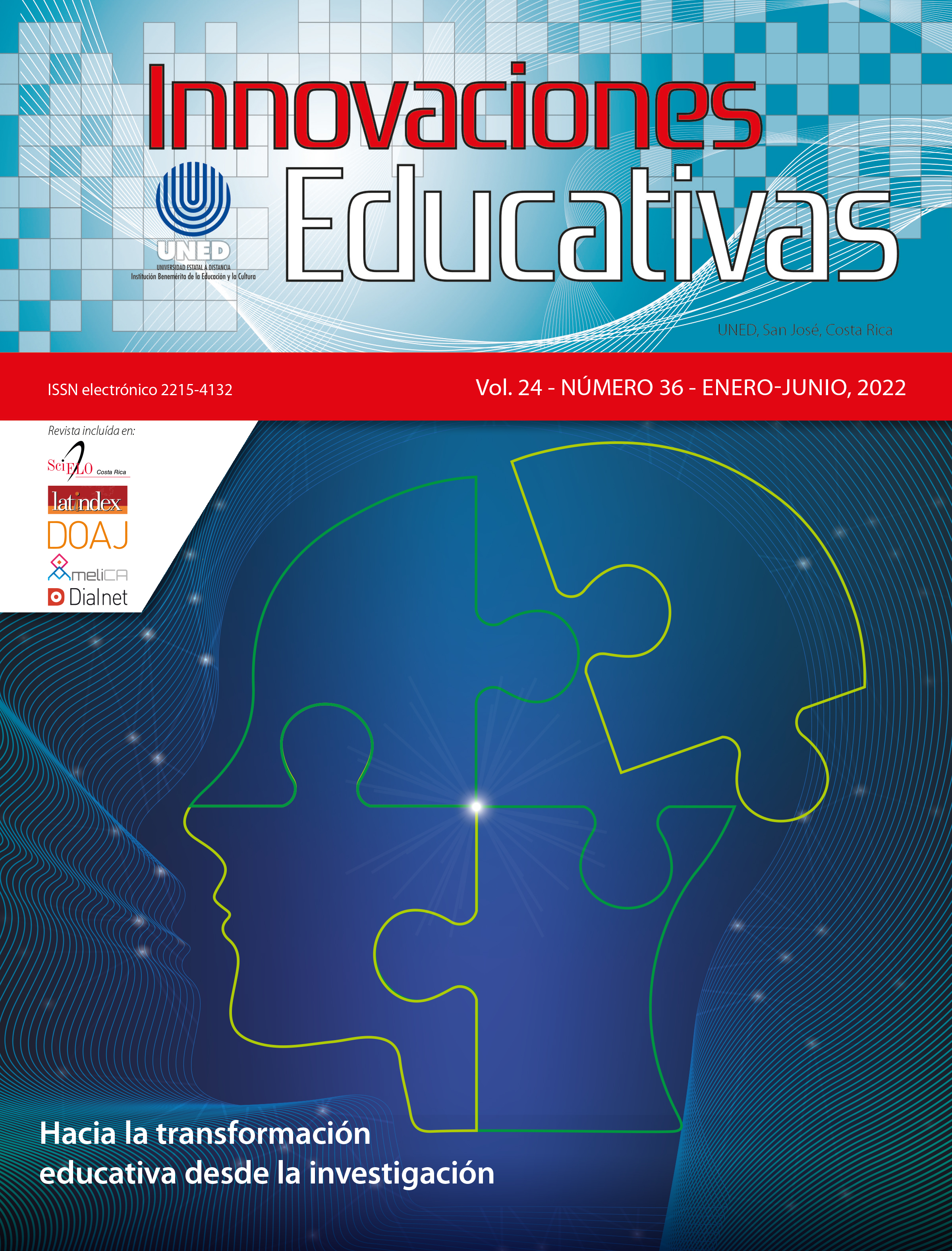Assessment of a didactic situation for teaching the random variable and probability distribution in Chilean secondary education
DOI:
https://doi.org/10.22458/ie.v24i36.3897Keywords:
random variable, probability distribution, education theory, teaching of statistics, secondary education, educationAbstract
The random variable and its probability distribution are fundamental concepts in statistical and probabilistic school education because they manifest in everyday experiences. Teaching them becomes a complex task due primarily to the difficulties associated with understanding them and the concept of function. Therefore, we proposed as a study objective to assess the random variable's instruction process and its probability distribution in Chilean secondary education, based on the Theory of Didactic Situations (TSD) and the Theory of Registration of Semiotic Representations (TRRS). We designed a test containing a didactic situation applied to 10th-grade Chilean students (15 to 16 years old) with a qualitative perspective and a descriptive-interpretive approach. The findings showed that more than half of the students (64%) managed to identify and represent the random variable in verbal, figural, or tabular language, and a similar percentage (59%), its probability distribution. Concerning the TRRS, this could indicate that students are in the process of building both objects. Subsequently from the TSD, we observed the vital role that the teacher played in the phases of the said didactic situation. Studying didactic theories, we discovered that bringing complex objects to the classroom can help actual teachers and those being trained to look at their practice with more understructure to make it more accessible and understandable to their students.
References
ACOSTA, M., MONROY, L. y RUEDA, K. (2010). Situaciones a-didácticas para la enseñanza de la simetría axial utilizando Cabri como medio. Revista Integración, 28(2), 173–189.
BATANERO, C. (2001). Didáctica de la estadística. Granada, España: Universidad de Granada.
BATANERO, C. (2004) Ideas estocásticas fundamentales ¿qué contenido se debe enseñar en la clase de probabilidades? En J. Fernández, M. Sousa y S. Ribeiro (Eds.), Actas do I Encontro de Probabilidades e Estatística na Escola (pp. 9-30). Braga, Portugal: Centro de Investigação em Educação da Universidade do Minho.
BIZET, V. (2017). Una secuencia didáctica para el aprendizaje del concepto de variable aleatoria desde la teoría de situaciones didácticas (Tesis de maestría). Pontificia Universidad Católica de Valparaíso, Chile.
BROUSSEAU, G. (1998). Théorie des Situations Didactiques. Grenoble, Francia: La pensée sauvage.
BROUSSEAU, G. (2007). Iniciación al estudio de la teoría de las situaciones didácticas. Buenos Aires, Argentina: Libros del Zorzal.
DOUKHAN, C. y GUEUDET, G. (2019). Students’ difficulties at the secondary-tertiary transition: the case of random variables. En U. Jankvist, M. van den Heuvel-Panhuizen y M. Veldhuis (Eds.), Proceedings of the Eleventh Congress of the European Society for Research in Mathematics Education (pp. 2464-2471). Utrecht, Países Bajos: Freudenthal Group y Freudenthal Institute of the Utrecht University y ERME.
DUVAL, R. (2006). Un tema crucial en la educación matemática: la habilidad para cambiar el registro de representación. Gaceta de la Real Sociedad Matemática Española, 9(1), 143-168.
FERNÁNDEZ, F.; ANDRADE, L.; MONTAÑEZ, J.; BELTRÁN, J. y ZAMORA, S. (2011). Hacia una posible aproximación comprensiva de la variable aleatoria. Trabajo presentado en la XIII Conferência Interamericana de Educação Matemática. Recife, Brasil: CIAEM.
FLICK, U. (2004). Introducción a la investigación cualitativa. Madrid, España: Ediciones Morata.
FLORES, B.; GARCÍA, J. y SÁNCHEZ, E. (2014). Avances en la calidad de las respuestas a preguntas de probabilidad después de una actividad de aprendizaje con tecnología. En M. González, M. Codes, D. Arnau y T. Ortega (Eds.). Investigación en Educación Matemática XVIII (pp. 307-316). Salamanca, España: SEIEM.
HEITELE, D. (1975). An epistemological view of fundamental stochastic ideas. Educational Studies in Mathematics, 6, 187–205.
HERNÁNDEZ, R.; FERNÁNDEZ, C. y BAPTISTA, P. (2006). Metodología de la investigación. Ciudad de México, México: McGraw-Hill.
LANDÍN, P. y SALINAS, J. (2016). Probabilistic reasoning of high school students on sample space and probability of compound events. Trabajo presentado en el 13th International Congress on Mathematical Education. Hamburgo, Alemania: ICMI.
NATIONAL COUNCIL OF TEACHERS OF MATHEMATICS (2000). Principles and standards for school mathematics. Reston, Estados Unidos: NCTM.
MINISTERIO DE EDUCACIÓN DE CHILE (2015). Bases Curriculares 7° básico a 2° medio. Gobierno de Chile. Santiago, Chile: Unidad de Currículum y Evaluación.
MINISTERIO DE EDUCACIÓN DE CHILE (2016). Matemática. Programa de estudio segundo medio. Gobierno de Chile. Santiago, Chile: Unidad de Currículum y Evaluación.
MINISTERIO DE EDUCACIÓN, CULTURA Y DEPORTE (2015). Real Decreto 1105/2014, de 26 de diciembre, por el que se establece el currículo básico de la Educación Secundaria Obligatoria y del Bachillerato. Boletín Oficial del Estado, 3, 135.
PRADA-NÚÑEZ, R.; HERNÁNDEZ-SUÁREZ, C. y JAIMES, L. (2017). Representación semiótica de la noción de función: concepciones de los estudiantes que transitan del colegio a la universidad. Panorama, 11(20), 34-44.
SALAZAR, R. (2014). La variable aleatoria con probabilidad desde la perspectiva de la teoría APOE (Tesis de maestría). Pontificia Universidad Católica de Valparaíso, Chile.
SÁNCHEZ, E. y GÓMEZ-BLANCARTE, A. L. (2011). El desarrollo del pensamiento estadístico de profesores de secundaria en servicio. En J. Godino (Ed.), Investigaciones actuales en Educación Estadística y Formación de Profesores (pp. 55-72). Granada, España: Universidad de Granada.
YANG, X. (2014). Conception and characteristics of expert mathematics teachers in China. Wiesbaden, Alemania: Springer.

